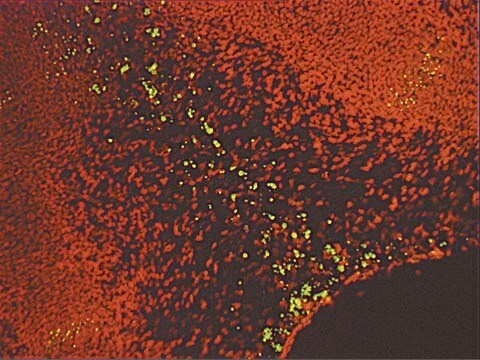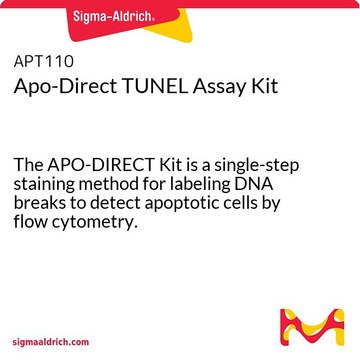APT1000
ApopTag ISOL Dual Fluorescence Apoptosis Detection Kit (DNase Types I & II)
The ApopTag ISOL Dual Fluorescence Kit utilizes a proprietary double hairpin, dual fluorescently labeled oligonucleotide labeling process to detect & distinguish between typical apoptotic DNA breaks induced by either DNase I or DNase II.
ログイン組織・契約価格を表示する
すべての画像(2)
About This Item
UNSPSCコード:
12161503
eCl@ss:
32161000
おすすめの製品
交差性(ホモロジーによる予測)
all
メーカー/製品名
ApopTag
Chemicon®
輸送温度
dry ice
詳細
The ApopTag ISOL Dual Fluorescence Kit utilizes a proprietary double hairpin, dual fluorescently labeled oligonucleotide labeling process to detect and distinguish between typical apoptotic DNA breaks induced by either DNase I or DNase II enzyme activities. The Vaccinia Topoisomerase I mediated ligation reaction is adaptable for staining paraffin-embedded tissue, frozen tissue sections, cell suspensions, and adherent cells. In situ staining for DNA fragmentation (as in the ISOL method) is both a means of detection for rare cells and an analytical test of those cells′ DNA. ApopTag ISOL Kits facilitate the differentiation of apoptotic cells from necrotic or transiently damaged cells. While conventional in situ detection techniques such as ISEL (Klenow DNA polymerase), TUNEL (terminal deoxynucleotidyl transferase, TdT) and ISNT (DNA Polymerase I) are useful in detecting internucleosomal DNA cleavage, they do not differentiate DNase Type I and DNase Type II cleavage which results from the activation of apoptotic endonucleases. When ISOL was used for direct comparison with TUNEL in specimens without necrosis, the results have been concordant. In specimens presenting necrosis, the better selectivity of ISOL was proven.
The ApopTag ISOL Fluorescence Apoptosis Detection (DNase Types I & II) technique is based upon the biochemical specificity of the enzymes T4 DNA ligase and Vaccinia Virus DNA Topoisomerase I and the unique, dual labeled, dual hairpin oligonucleotide (8,9,10). This self-annealing oligo contains two sets of complementary base sequences that spontaneously form two duplex segments resulting in a dual hairpin secondary structure (Figure 1). The oligo also contains two internal fluorescent labels which are located at opposite poles of the dual hairpin structure. At one pole is a FAM internal label and the other pole contains a CR590 label. The basis of the detection mechanism relies on the 5′-CCCTT-3′ Topoisomerase I recognition site located in the middle of the dual hairpin structure. The Topoisomerase I cuts the DNA at the 3′ end of the recognition site causing the dual hairpin oligo to dissociate into two separate differentially labeled hairpin oligonucleotides. The Toposiomerase I remains covalently bound to the oligo containing the recognition site and the FAM label while the other CR590 containing oligo dissociates. Hence, two differentially labeled hairpin oligo probes are created. The biochemical specificity of the provided enzymes impacts the detection aspect of the protocol, in that Vaccinia Topoisomerase I will recognize and ligate the FAM oligo to 5′-OH 3′-PO4 groups (DNase type II specific cut) whereas T4 DNA Ligase will recognize and ligate the CR590 labeled oligo to 5′-PO4 3′-OH groups (DNase type I specific cut). The ISOL Kit does not label nicks, gaps, single-stranded DNA, 3′-recessed ends or 3′-overhanging ends.
アプリケーション
Research Category
アポトーシス及び癌
アポトーシス及び癌
構成
T4 DNA Ligase Enzyme (Part. No.2007460) - 100 μL
Dual Reaction Buffer (2X) (Part. No.2007464) - 375 μL
Dual Labeled Oligo (Part. No.2007463) - 25 μL
Vaccinia Topoisomerase I (Part. No. 2007459) - 250 μL
Plastic Coverslips (Part. No. 90421) - 100 each
Positive Control Slides (Part. No. 90422) - 2 each
Proteinase K (Part. No. 90435) - 25 mg
Dual Reaction Buffer (2X) (Part. No.2007464) - 375 μL
Dual Labeled Oligo (Part. No.2007463) - 25 μL
Vaccinia Topoisomerase I (Part. No. 2007459) - 250 μL
Plastic Coverslips (Part. No. 90421) - 100 each
Positive Control Slides (Part. No. 90422) - 2 each
Proteinase K (Part. No. 90435) - 25 mg
保管および安定性
1 year at -20°C from date of shipment
法的情報
CHEMICON is a registered trademark of Merck KGaA, Darmstadt, Germany
免責事項
Unless otherwise stated in our catalog or other company documentation accompanying the product(s), our products are intended for research use only and are not to be used for any other purpose, which includes but is not limited to, unauthorized commercial uses, in vitro diagnostic uses, ex vivo or in vivo therapeutic uses or any type of consumption or application to humans or animals.
シグナルワード
Danger
危険有害性情報
危険有害性の分類
Eye Irrit. 2 - Resp. Sens. 1 - Skin Irrit. 2 - STOT SE 3
ターゲットの組織
Respiratory system
保管分類コード
10 - Combustible liquids
適用法令
試験研究用途を考慮した関連法令を主に挙げております。化学物質以外については、一部の情報のみ提供しています。 製品を安全かつ合法的に使用することは、使用者の義務です。最新情報により修正される場合があります。WEBの反映には時間を要することがあるため、適宜SDSをご参照ください。
毒物及び劇物取締法
キットコンポーネントの情報を参照してください
PRTR
キットコンポーネントの情報を参照してください
消防法
キットコンポーネントの情報を参照してください
労働安全衛生法名称等を表示すべき危険物及び有害物
キットコンポーネントの情報を参照してください
労働安全衛生法名称等を通知すべき危険物及び有害物
キットコンポーネントの情報を参照してください
カルタヘナ法
キットコンポーネントの情報を参照してください
Jan Code
キットコンポーネントの情報を参照してください
試験成績書(COA)
製品のロット番号・バッチ番号を入力して、試験成績書(COA) を検索できます。ロット番号・バッチ番号は、製品ラベルに「Lot」または「Batch」に続いて記載されています。
W Bursch et al.
Carcinogenesis, 11(5), 847-853 (1990-05-01)
Apoptosis is a form of cell death involved in the regulation of cell number in various organs and tumors. Quantitative determination of cell loss through apoptosis in histological sections requires, in addition to counts of apoptotic cells, information on the
A simple and rapid method for detection of apoptosis in human cells
Rosl, F
Nucleic Acids Research, 20, 5243-5243 (1992)
Semi-artificial Fluorescent Molecular Machine for DNA Damage Detection
Didenko VV, Minchew CL, Shuman S, Baskin DS.
Nano Letters null
Ultrastructural detection of DNA strand breaks in apoptotic neural cells by in situ end-labelling techniques.
Migheli, A, et al.
The Journal of Pathology, 176, 27-35 (1995)
J Sträter et al.
Histochemistry and cell biology, 103(2), 157-160 (1995-02-01)
Apoptosis is a morphologically distinct form of programmed cell death that plays an important role in the growth regulation of a variety of tissues and also in the elimination of self-reacting immunocompetent cells. Several techniques for the qualitative and quantitative
ライフサイエンス、有機合成、材料科学、クロマトグラフィー、分析など、あらゆる分野の研究に経験のあるメンバーがおります。.
製品に関するお問い合わせはこちら(テクニカルサービス)








